RISK ASSESSMENT REPORT.
VerifiedAdded on 2023/03/23
|12
|2832
|38
AI Summary
Contribute Materials
Your contribution can guide someone’s learning journey. Share your
documents today.
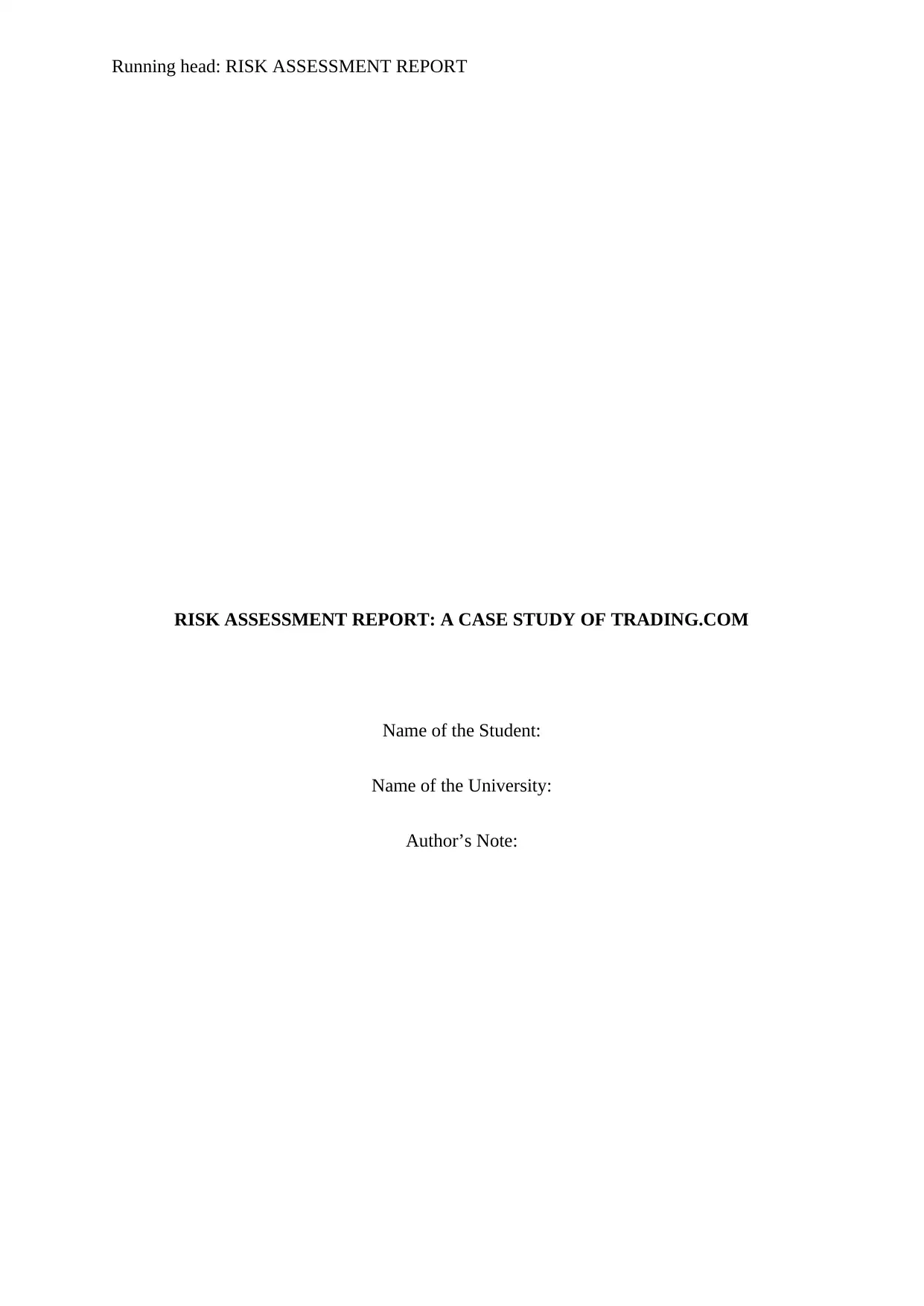
Running head: RISK ASSESSMENT REPORT
RISK ASSESSMENT REPORT: A CASE STUDY OF TRADING.COM
Name of the Student:
Name of the University:
Author’s Note:
RISK ASSESSMENT REPORT: A CASE STUDY OF TRADING.COM
Name of the Student:
Name of the University:
Author’s Note:
Secure Best Marks with AI Grader
Need help grading? Try our AI Grader for instant feedback on your assignments.
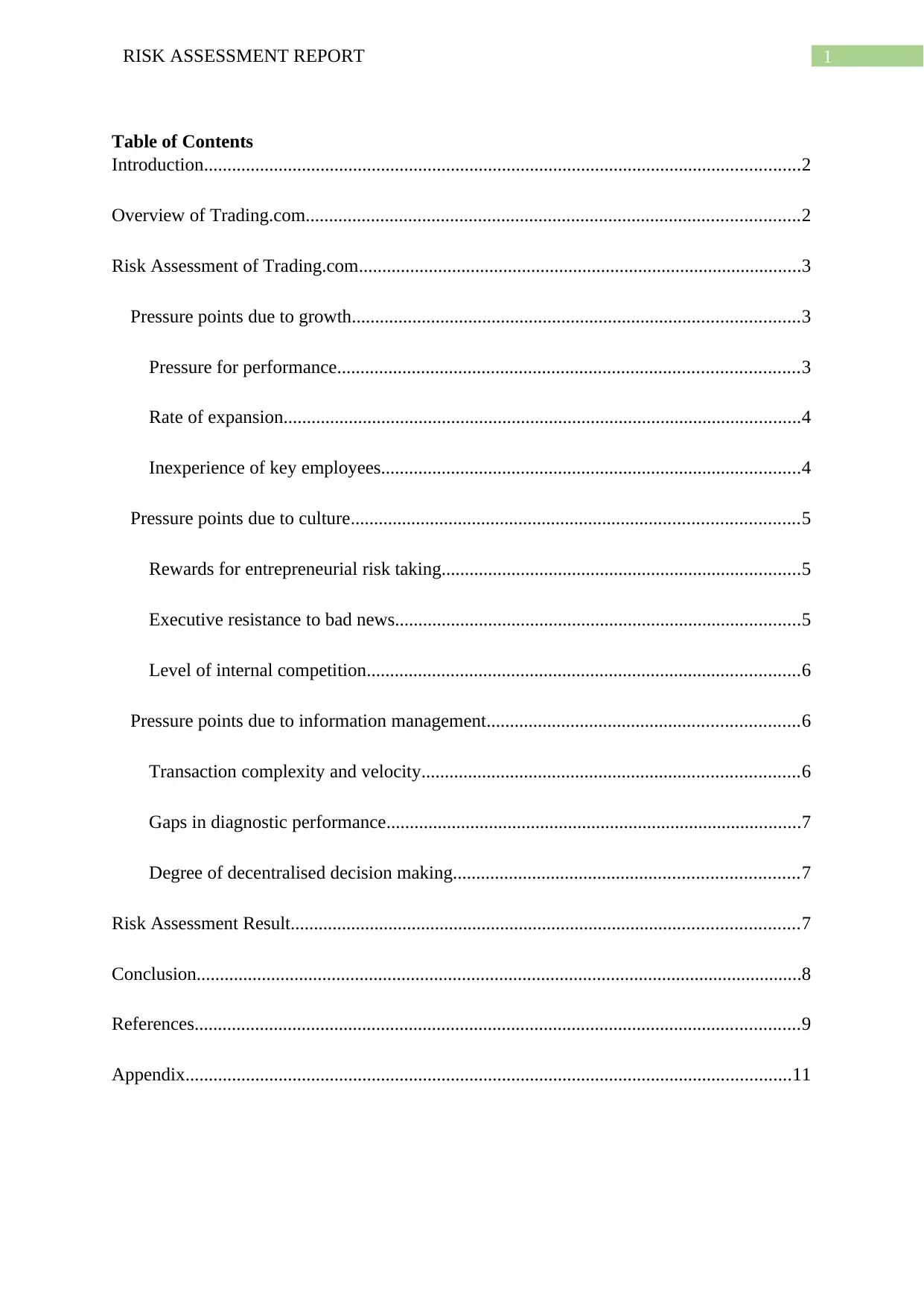
1RISK ASSESSMENT REPORT
Table of Contents
Introduction................................................................................................................................2
Overview of Trading.com..........................................................................................................2
Risk Assessment of Trading.com...............................................................................................3
Pressure points due to growth................................................................................................3
Pressure for performance...................................................................................................3
Rate of expansion...............................................................................................................4
Inexperience of key employees..........................................................................................4
Pressure points due to culture................................................................................................5
Rewards for entrepreneurial risk taking.............................................................................5
Executive resistance to bad news.......................................................................................5
Level of internal competition.............................................................................................6
Pressure points due to information management...................................................................6
Transaction complexity and velocity.................................................................................6
Gaps in diagnostic performance.........................................................................................7
Degree of decentralised decision making..........................................................................7
Risk Assessment Result.............................................................................................................7
Conclusion..................................................................................................................................8
References..................................................................................................................................9
Appendix..................................................................................................................................11
Table of Contents
Introduction................................................................................................................................2
Overview of Trading.com..........................................................................................................2
Risk Assessment of Trading.com...............................................................................................3
Pressure points due to growth................................................................................................3
Pressure for performance...................................................................................................3
Rate of expansion...............................................................................................................4
Inexperience of key employees..........................................................................................4
Pressure points due to culture................................................................................................5
Rewards for entrepreneurial risk taking.............................................................................5
Executive resistance to bad news.......................................................................................5
Level of internal competition.............................................................................................6
Pressure points due to information management...................................................................6
Transaction complexity and velocity.................................................................................6
Gaps in diagnostic performance.........................................................................................7
Degree of decentralised decision making..........................................................................7
Risk Assessment Result.............................................................................................................7
Conclusion..................................................................................................................................8
References..................................................................................................................................9
Appendix..................................................................................................................................11
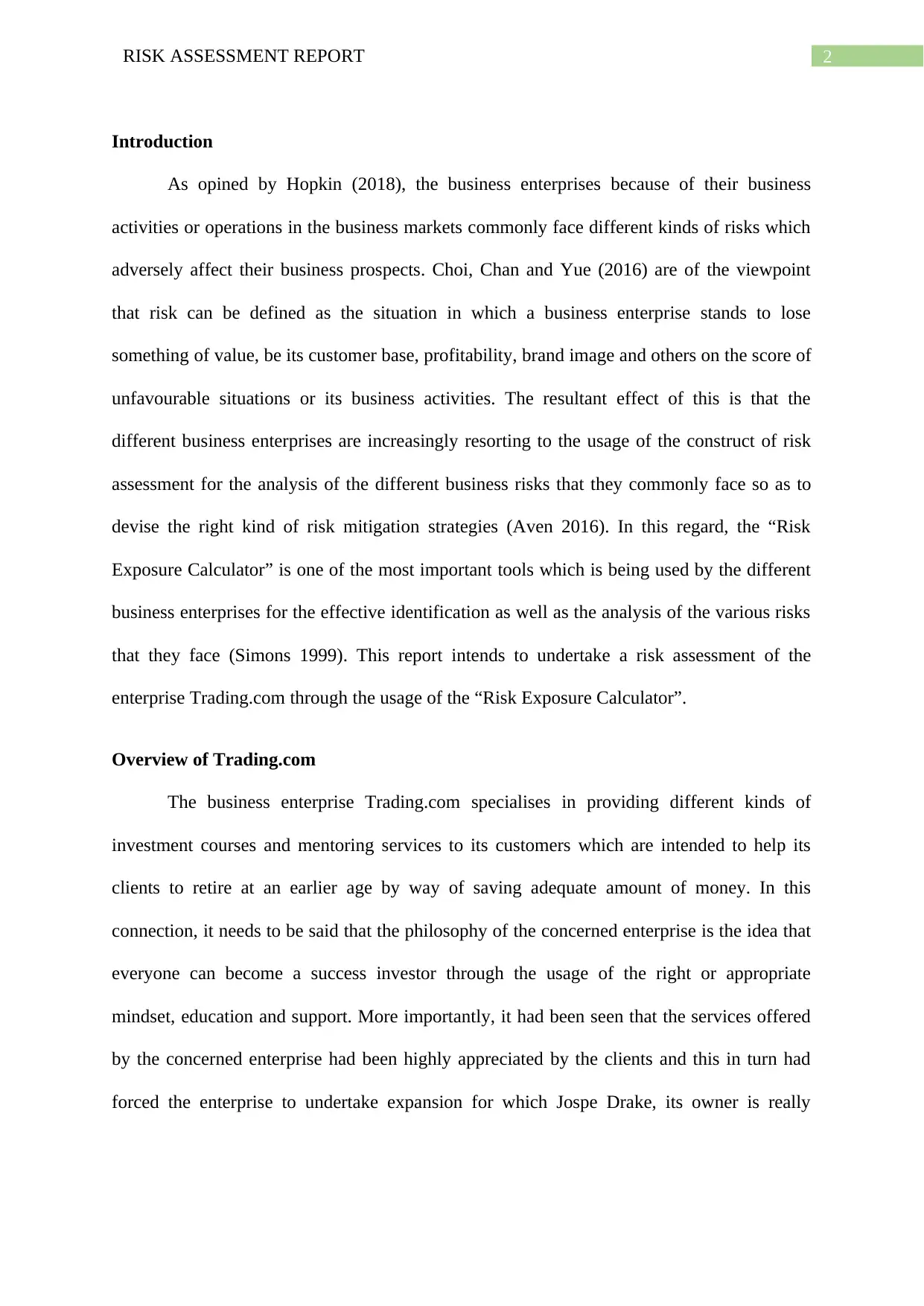
2RISK ASSESSMENT REPORT
Introduction
As opined by Hopkin (2018), the business enterprises because of their business
activities or operations in the business markets commonly face different kinds of risks which
adversely affect their business prospects. Choi, Chan and Yue (2016) are of the viewpoint
that risk can be defined as the situation in which a business enterprise stands to lose
something of value, be its customer base, profitability, brand image and others on the score of
unfavourable situations or its business activities. The resultant effect of this is that the
different business enterprises are increasingly resorting to the usage of the construct of risk
assessment for the analysis of the different business risks that they commonly face so as to
devise the right kind of risk mitigation strategies (Aven 2016). In this regard, the “Risk
Exposure Calculator” is one of the most important tools which is being used by the different
business enterprises for the effective identification as well as the analysis of the various risks
that they face (Simons 1999). This report intends to undertake a risk assessment of the
enterprise Trading.com through the usage of the “Risk Exposure Calculator”.
Overview of Trading.com
The business enterprise Trading.com specialises in providing different kinds of
investment courses and mentoring services to its customers which are intended to help its
clients to retire at an earlier age by way of saving adequate amount of money. In this
connection, it needs to be said that the philosophy of the concerned enterprise is the idea that
everyone can become a success investor through the usage of the right or appropriate
mindset, education and support. More importantly, it had been seen that the services offered
by the concerned enterprise had been highly appreciated by the clients and this in turn had
forced the enterprise to undertake expansion for which Jospe Drake, its owner is really
Introduction
As opined by Hopkin (2018), the business enterprises because of their business
activities or operations in the business markets commonly face different kinds of risks which
adversely affect their business prospects. Choi, Chan and Yue (2016) are of the viewpoint
that risk can be defined as the situation in which a business enterprise stands to lose
something of value, be its customer base, profitability, brand image and others on the score of
unfavourable situations or its business activities. The resultant effect of this is that the
different business enterprises are increasingly resorting to the usage of the construct of risk
assessment for the analysis of the different business risks that they commonly face so as to
devise the right kind of risk mitigation strategies (Aven 2016). In this regard, the “Risk
Exposure Calculator” is one of the most important tools which is being used by the different
business enterprises for the effective identification as well as the analysis of the various risks
that they face (Simons 1999). This report intends to undertake a risk assessment of the
enterprise Trading.com through the usage of the “Risk Exposure Calculator”.
Overview of Trading.com
The business enterprise Trading.com specialises in providing different kinds of
investment courses and mentoring services to its customers which are intended to help its
clients to retire at an earlier age by way of saving adequate amount of money. In this
connection, it needs to be said that the philosophy of the concerned enterprise is the idea that
everyone can become a success investor through the usage of the right or appropriate
mindset, education and support. More importantly, it had been seen that the services offered
by the concerned enterprise had been highly appreciated by the clients and this in turn had
forced the enterprise to undertake expansion for which Jospe Drake, its owner is really
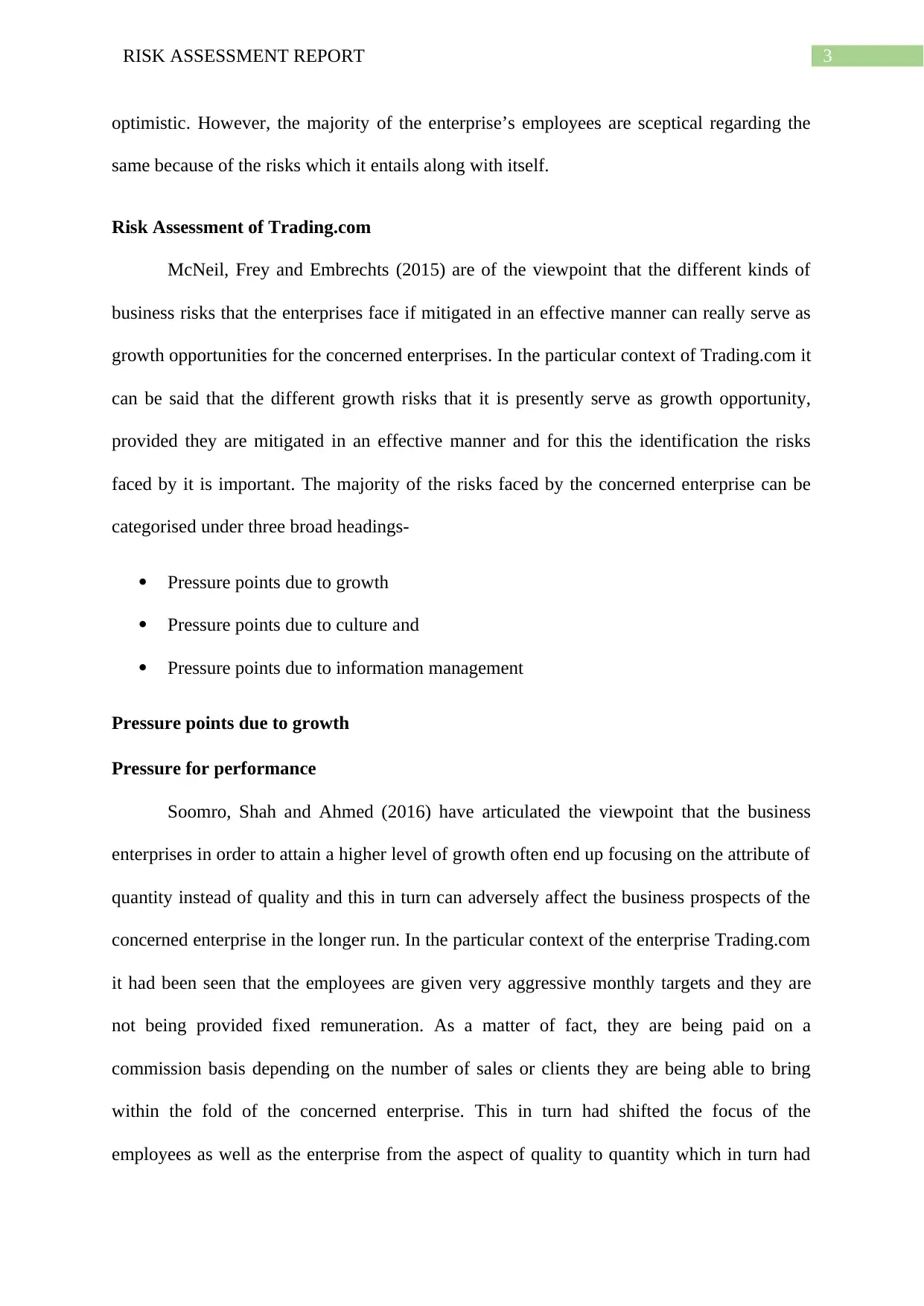
3RISK ASSESSMENT REPORT
optimistic. However, the majority of the enterprise’s employees are sceptical regarding the
same because of the risks which it entails along with itself.
Risk Assessment of Trading.com
McNeil, Frey and Embrechts (2015) are of the viewpoint that the different kinds of
business risks that the enterprises face if mitigated in an effective manner can really serve as
growth opportunities for the concerned enterprises. In the particular context of Trading.com it
can be said that the different growth risks that it is presently serve as growth opportunity,
provided they are mitigated in an effective manner and for this the identification the risks
faced by it is important. The majority of the risks faced by the concerned enterprise can be
categorised under three broad headings-
Pressure points due to growth
Pressure points due to culture and
Pressure points due to information management
Pressure points due to growth
Pressure for performance
Soomro, Shah and Ahmed (2016) have articulated the viewpoint that the business
enterprises in order to attain a higher level of growth often end up focusing on the attribute of
quantity instead of quality and this in turn can adversely affect the business prospects of the
concerned enterprise in the longer run. In the particular context of the enterprise Trading.com
it had been seen that the employees are given very aggressive monthly targets and they are
not being provided fixed remuneration. As a matter of fact, they are being paid on a
commission basis depending on the number of sales or clients they are being able to bring
within the fold of the concerned enterprise. This in turn had shifted the focus of the
employees as well as the enterprise from the aspect of quality to quantity which in turn had
optimistic. However, the majority of the enterprise’s employees are sceptical regarding the
same because of the risks which it entails along with itself.
Risk Assessment of Trading.com
McNeil, Frey and Embrechts (2015) are of the viewpoint that the different kinds of
business risks that the enterprises face if mitigated in an effective manner can really serve as
growth opportunities for the concerned enterprises. In the particular context of Trading.com it
can be said that the different growth risks that it is presently serve as growth opportunity,
provided they are mitigated in an effective manner and for this the identification the risks
faced by it is important. The majority of the risks faced by the concerned enterprise can be
categorised under three broad headings-
Pressure points due to growth
Pressure points due to culture and
Pressure points due to information management
Pressure points due to growth
Pressure for performance
Soomro, Shah and Ahmed (2016) have articulated the viewpoint that the business
enterprises in order to attain a higher level of growth often end up focusing on the attribute of
quantity instead of quality and this in turn can adversely affect the business prospects of the
concerned enterprise in the longer run. In the particular context of the enterprise Trading.com
it had been seen that the employees are given very aggressive monthly targets and they are
not being provided fixed remuneration. As a matter of fact, they are being paid on a
commission basis depending on the number of sales or clients they are being able to bring
within the fold of the concerned enterprise. This in turn had shifted the focus of the
employees as well as the enterprise from the aspect of quality to quantity which in turn had
Secure Best Marks with AI Grader
Need help grading? Try our AI Grader for instant feedback on your assignments.
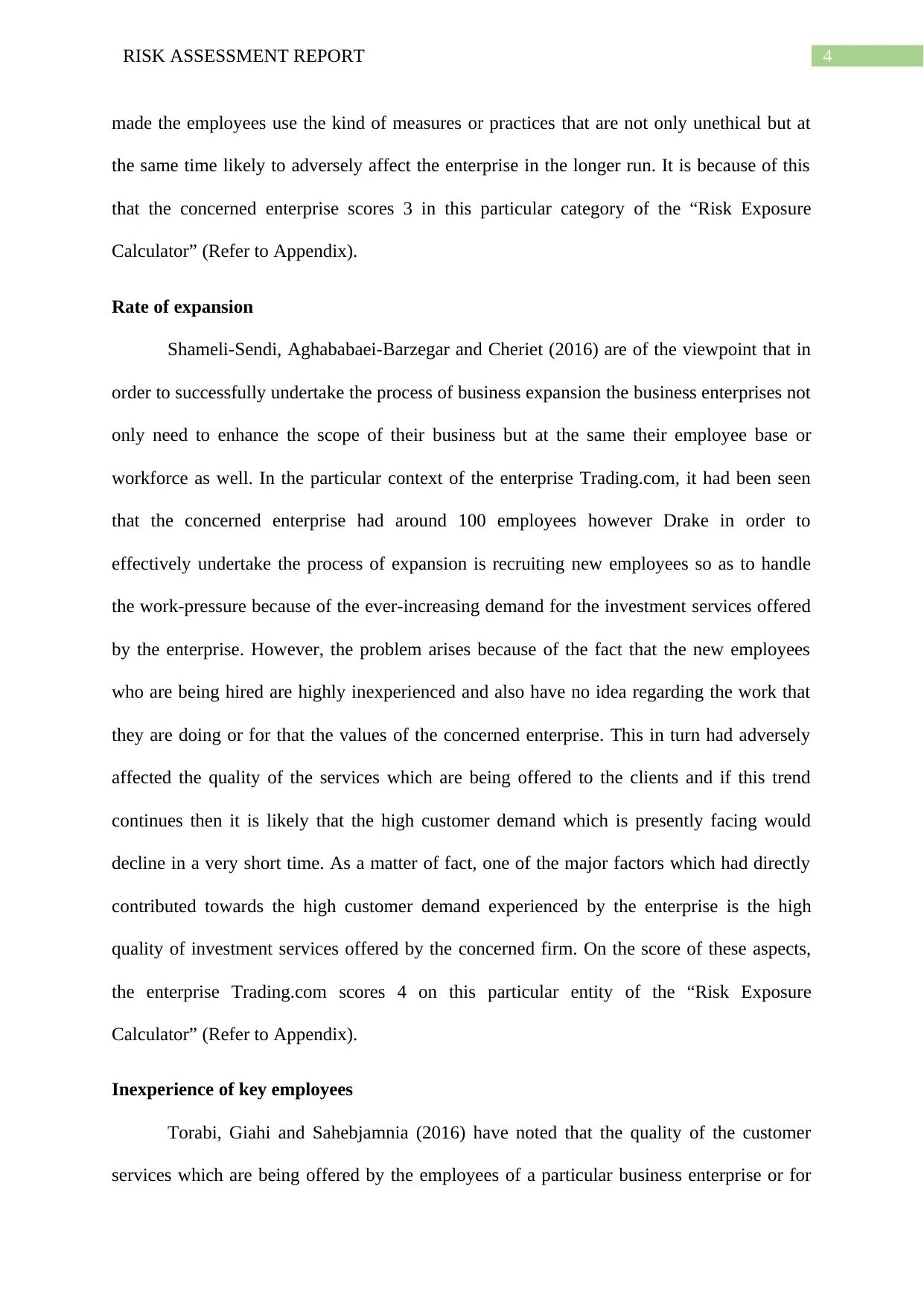
4RISK ASSESSMENT REPORT
made the employees use the kind of measures or practices that are not only unethical but at
the same time likely to adversely affect the enterprise in the longer run. It is because of this
that the concerned enterprise scores 3 in this particular category of the “Risk Exposure
Calculator” (Refer to Appendix).
Rate of expansion
Shameli-Sendi, Aghababaei-Barzegar and Cheriet (2016) are of the viewpoint that in
order to successfully undertake the process of business expansion the business enterprises not
only need to enhance the scope of their business but at the same their employee base or
workforce as well. In the particular context of the enterprise Trading.com, it had been seen
that the concerned enterprise had around 100 employees however Drake in order to
effectively undertake the process of expansion is recruiting new employees so as to handle
the work-pressure because of the ever-increasing demand for the investment services offered
by the enterprise. However, the problem arises because of the fact that the new employees
who are being hired are highly inexperienced and also have no idea regarding the work that
they are doing or for that the values of the concerned enterprise. This in turn had adversely
affected the quality of the services which are being offered to the clients and if this trend
continues then it is likely that the high customer demand which is presently facing would
decline in a very short time. As a matter of fact, one of the major factors which had directly
contributed towards the high customer demand experienced by the enterprise is the high
quality of investment services offered by the concerned firm. On the score of these aspects,
the enterprise Trading.com scores 4 on this particular entity of the “Risk Exposure
Calculator” (Refer to Appendix).
Inexperience of key employees
Torabi, Giahi and Sahebjamnia (2016) have noted that the quality of the customer
services which are being offered by the employees of a particular business enterprise or for
made the employees use the kind of measures or practices that are not only unethical but at
the same time likely to adversely affect the enterprise in the longer run. It is because of this
that the concerned enterprise scores 3 in this particular category of the “Risk Exposure
Calculator” (Refer to Appendix).
Rate of expansion
Shameli-Sendi, Aghababaei-Barzegar and Cheriet (2016) are of the viewpoint that in
order to successfully undertake the process of business expansion the business enterprises not
only need to enhance the scope of their business but at the same their employee base or
workforce as well. In the particular context of the enterprise Trading.com, it had been seen
that the concerned enterprise had around 100 employees however Drake in order to
effectively undertake the process of expansion is recruiting new employees so as to handle
the work-pressure because of the ever-increasing demand for the investment services offered
by the enterprise. However, the problem arises because of the fact that the new employees
who are being hired are highly inexperienced and also have no idea regarding the work that
they are doing or for that the values of the concerned enterprise. This in turn had adversely
affected the quality of the services which are being offered to the clients and if this trend
continues then it is likely that the high customer demand which is presently facing would
decline in a very short time. As a matter of fact, one of the major factors which had directly
contributed towards the high customer demand experienced by the enterprise is the high
quality of investment services offered by the concerned firm. On the score of these aspects,
the enterprise Trading.com scores 4 on this particular entity of the “Risk Exposure
Calculator” (Refer to Appendix).
Inexperience of key employees
Torabi, Giahi and Sahebjamnia (2016) have noted that the quality of the customer
services which are being offered by the employees of a particular business enterprise or for
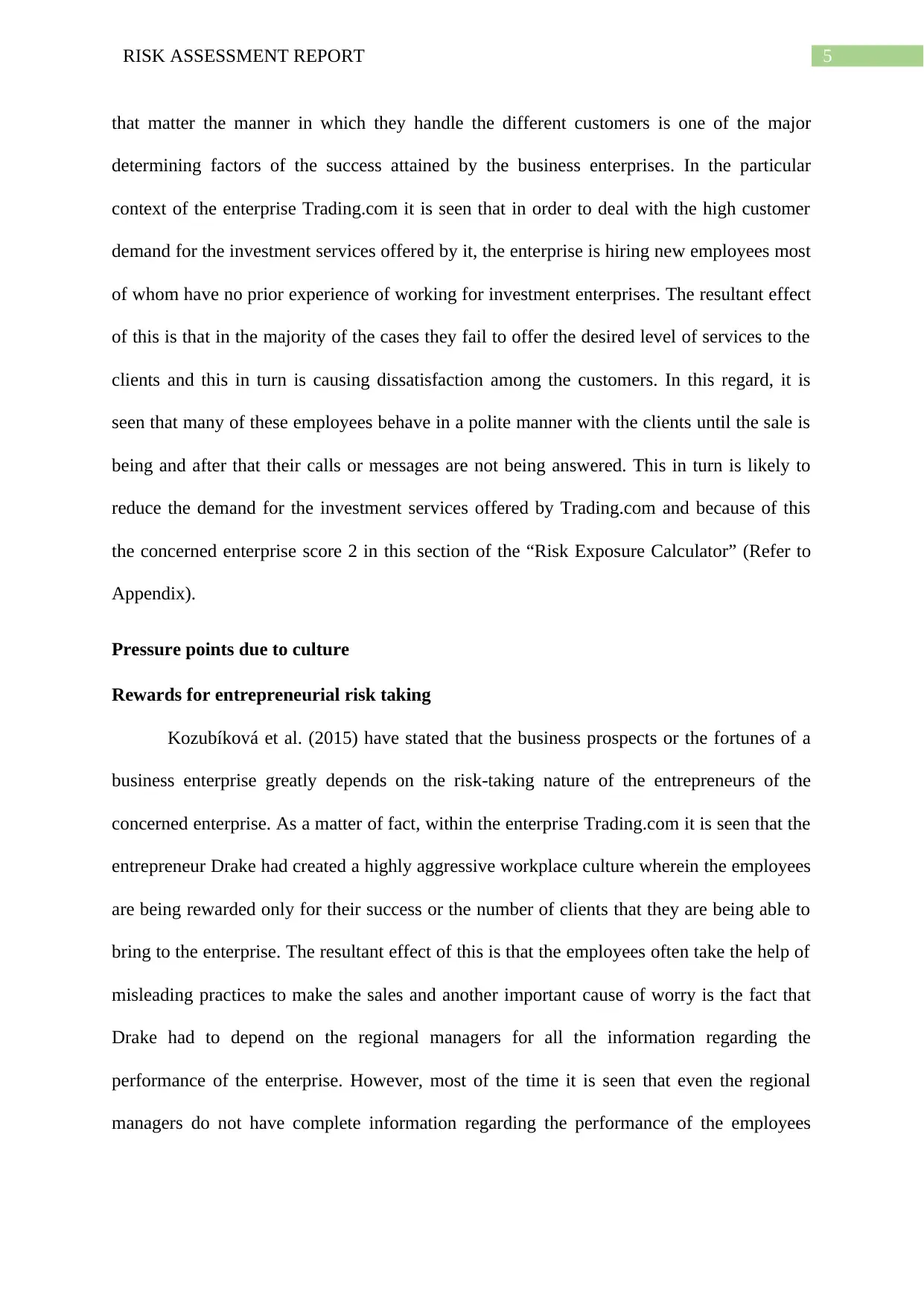
5RISK ASSESSMENT REPORT
that matter the manner in which they handle the different customers is one of the major
determining factors of the success attained by the business enterprises. In the particular
context of the enterprise Trading.com it is seen that in order to deal with the high customer
demand for the investment services offered by it, the enterprise is hiring new employees most
of whom have no prior experience of working for investment enterprises. The resultant effect
of this is that in the majority of the cases they fail to offer the desired level of services to the
clients and this in turn is causing dissatisfaction among the customers. In this regard, it is
seen that many of these employees behave in a polite manner with the clients until the sale is
being and after that their calls or messages are not being answered. This in turn is likely to
reduce the demand for the investment services offered by Trading.com and because of this
the concerned enterprise score 2 in this section of the “Risk Exposure Calculator” (Refer to
Appendix).
Pressure points due to culture
Rewards for entrepreneurial risk taking
Kozubíková et al. (2015) have stated that the business prospects or the fortunes of a
business enterprise greatly depends on the risk-taking nature of the entrepreneurs of the
concerned enterprise. As a matter of fact, within the enterprise Trading.com it is seen that the
entrepreneur Drake had created a highly aggressive workplace culture wherein the employees
are being rewarded only for their success or the number of clients that they are being able to
bring to the enterprise. The resultant effect of this is that the employees often take the help of
misleading practices to make the sales and another important cause of worry is the fact that
Drake had to depend on the regional managers for all the information regarding the
performance of the enterprise. However, most of the time it is seen that even the regional
managers do not have complete information regarding the performance of the employees
that matter the manner in which they handle the different customers is one of the major
determining factors of the success attained by the business enterprises. In the particular
context of the enterprise Trading.com it is seen that in order to deal with the high customer
demand for the investment services offered by it, the enterprise is hiring new employees most
of whom have no prior experience of working for investment enterprises. The resultant effect
of this is that in the majority of the cases they fail to offer the desired level of services to the
clients and this in turn is causing dissatisfaction among the customers. In this regard, it is
seen that many of these employees behave in a polite manner with the clients until the sale is
being and after that their calls or messages are not being answered. This in turn is likely to
reduce the demand for the investment services offered by Trading.com and because of this
the concerned enterprise score 2 in this section of the “Risk Exposure Calculator” (Refer to
Appendix).
Pressure points due to culture
Rewards for entrepreneurial risk taking
Kozubíková et al. (2015) have stated that the business prospects or the fortunes of a
business enterprise greatly depends on the risk-taking nature of the entrepreneurs of the
concerned enterprise. As a matter of fact, within the enterprise Trading.com it is seen that the
entrepreneur Drake had created a highly aggressive workplace culture wherein the employees
are being rewarded only for their success or the number of clients that they are being able to
bring to the enterprise. The resultant effect of this is that the employees often take the help of
misleading practices to make the sales and another important cause of worry is the fact that
Drake had to depend on the regional managers for all the information regarding the
performance of the enterprise. However, most of the time it is seen that even the regional
managers do not have complete information regarding the performance of the employees
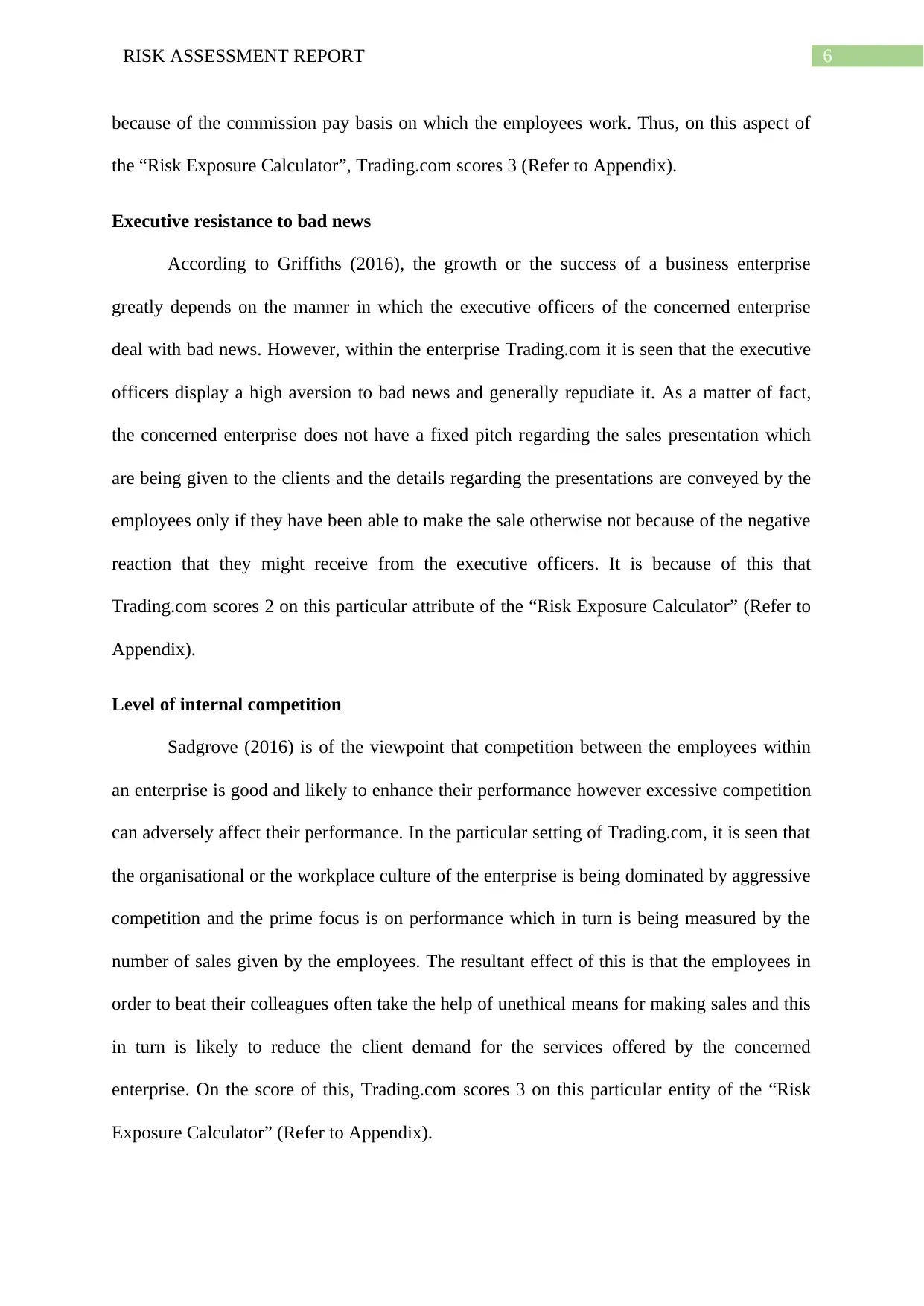
6RISK ASSESSMENT REPORT
because of the commission pay basis on which the employees work. Thus, on this aspect of
the “Risk Exposure Calculator”, Trading.com scores 3 (Refer to Appendix).
Executive resistance to bad news
According to Griffiths (2016), the growth or the success of a business enterprise
greatly depends on the manner in which the executive officers of the concerned enterprise
deal with bad news. However, within the enterprise Trading.com it is seen that the executive
officers display a high aversion to bad news and generally repudiate it. As a matter of fact,
the concerned enterprise does not have a fixed pitch regarding the sales presentation which
are being given to the clients and the details regarding the presentations are conveyed by the
employees only if they have been able to make the sale otherwise not because of the negative
reaction that they might receive from the executive officers. It is because of this that
Trading.com scores 2 on this particular attribute of the “Risk Exposure Calculator” (Refer to
Appendix).
Level of internal competition
Sadgrove (2016) is of the viewpoint that competition between the employees within
an enterprise is good and likely to enhance their performance however excessive competition
can adversely affect their performance. In the particular setting of Trading.com, it is seen that
the organisational or the workplace culture of the enterprise is being dominated by aggressive
competition and the prime focus is on performance which in turn is being measured by the
number of sales given by the employees. The resultant effect of this is that the employees in
order to beat their colleagues often take the help of unethical means for making sales and this
in turn is likely to reduce the client demand for the services offered by the concerned
enterprise. On the score of this, Trading.com scores 3 on this particular entity of the “Risk
Exposure Calculator” (Refer to Appendix).
because of the commission pay basis on which the employees work. Thus, on this aspect of
the “Risk Exposure Calculator”, Trading.com scores 3 (Refer to Appendix).
Executive resistance to bad news
According to Griffiths (2016), the growth or the success of a business enterprise
greatly depends on the manner in which the executive officers of the concerned enterprise
deal with bad news. However, within the enterprise Trading.com it is seen that the executive
officers display a high aversion to bad news and generally repudiate it. As a matter of fact,
the concerned enterprise does not have a fixed pitch regarding the sales presentation which
are being given to the clients and the details regarding the presentations are conveyed by the
employees only if they have been able to make the sale otherwise not because of the negative
reaction that they might receive from the executive officers. It is because of this that
Trading.com scores 2 on this particular attribute of the “Risk Exposure Calculator” (Refer to
Appendix).
Level of internal competition
Sadgrove (2016) is of the viewpoint that competition between the employees within
an enterprise is good and likely to enhance their performance however excessive competition
can adversely affect their performance. In the particular setting of Trading.com, it is seen that
the organisational or the workplace culture of the enterprise is being dominated by aggressive
competition and the prime focus is on performance which in turn is being measured by the
number of sales given by the employees. The resultant effect of this is that the employees in
order to beat their colleagues often take the help of unethical means for making sales and this
in turn is likely to reduce the client demand for the services offered by the concerned
enterprise. On the score of this, Trading.com scores 3 on this particular entity of the “Risk
Exposure Calculator” (Refer to Appendix).
Paraphrase This Document
Need a fresh take? Get an instant paraphrase of this document with our AI Paraphraser
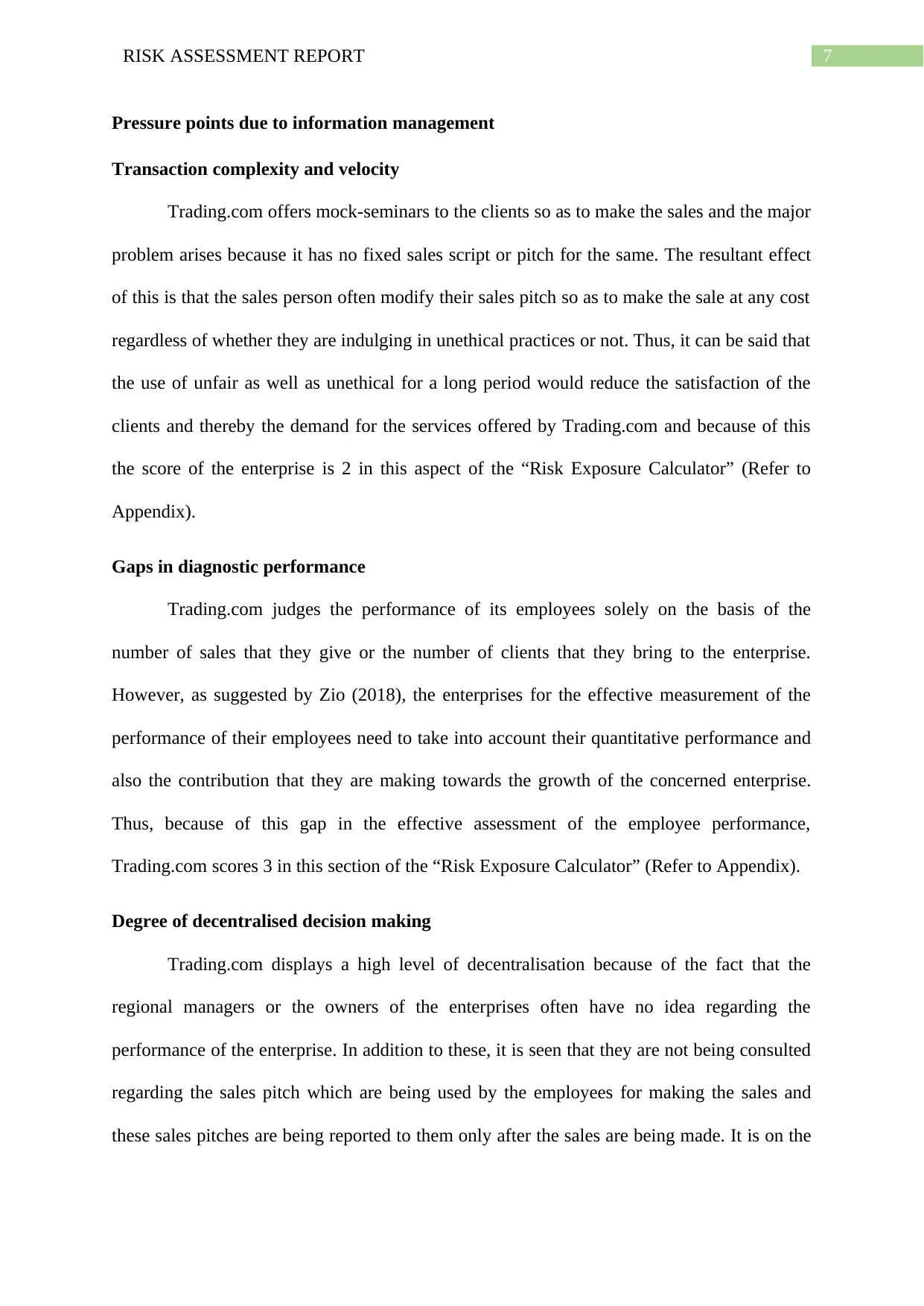
7RISK ASSESSMENT REPORT
Pressure points due to information management
Transaction complexity and velocity
Trading.com offers mock-seminars to the clients so as to make the sales and the major
problem arises because it has no fixed sales script or pitch for the same. The resultant effect
of this is that the sales person often modify their sales pitch so as to make the sale at any cost
regardless of whether they are indulging in unethical practices or not. Thus, it can be said that
the use of unfair as well as unethical for a long period would reduce the satisfaction of the
clients and thereby the demand for the services offered by Trading.com and because of this
the score of the enterprise is 2 in this aspect of the “Risk Exposure Calculator” (Refer to
Appendix).
Gaps in diagnostic performance
Trading.com judges the performance of its employees solely on the basis of the
number of sales that they give or the number of clients that they bring to the enterprise.
However, as suggested by Zio (2018), the enterprises for the effective measurement of the
performance of their employees need to take into account their quantitative performance and
also the contribution that they are making towards the growth of the concerned enterprise.
Thus, because of this gap in the effective assessment of the employee performance,
Trading.com scores 3 in this section of the “Risk Exposure Calculator” (Refer to Appendix).
Degree of decentralised decision making
Trading.com displays a high level of decentralisation because of the fact that the
regional managers or the owners of the enterprises often have no idea regarding the
performance of the enterprise. In addition to these, it is seen that they are not being consulted
regarding the sales pitch which are being used by the employees for making the sales and
these sales pitches are being reported to them only after the sales are being made. It is on the
Pressure points due to information management
Transaction complexity and velocity
Trading.com offers mock-seminars to the clients so as to make the sales and the major
problem arises because it has no fixed sales script or pitch for the same. The resultant effect
of this is that the sales person often modify their sales pitch so as to make the sale at any cost
regardless of whether they are indulging in unethical practices or not. Thus, it can be said that
the use of unfair as well as unethical for a long period would reduce the satisfaction of the
clients and thereby the demand for the services offered by Trading.com and because of this
the score of the enterprise is 2 in this aspect of the “Risk Exposure Calculator” (Refer to
Appendix).
Gaps in diagnostic performance
Trading.com judges the performance of its employees solely on the basis of the
number of sales that they give or the number of clients that they bring to the enterprise.
However, as suggested by Zio (2018), the enterprises for the effective measurement of the
performance of their employees need to take into account their quantitative performance and
also the contribution that they are making towards the growth of the concerned enterprise.
Thus, because of this gap in the effective assessment of the employee performance,
Trading.com scores 3 in this section of the “Risk Exposure Calculator” (Refer to Appendix).
Degree of decentralised decision making
Trading.com displays a high level of decentralisation because of the fact that the
regional managers or the owners of the enterprises often have no idea regarding the
performance of the enterprise. In addition to these, it is seen that they are not being consulted
regarding the sales pitch which are being used by the employees for making the sales and
these sales pitches are being reported to them only after the sales are being made. It is on the
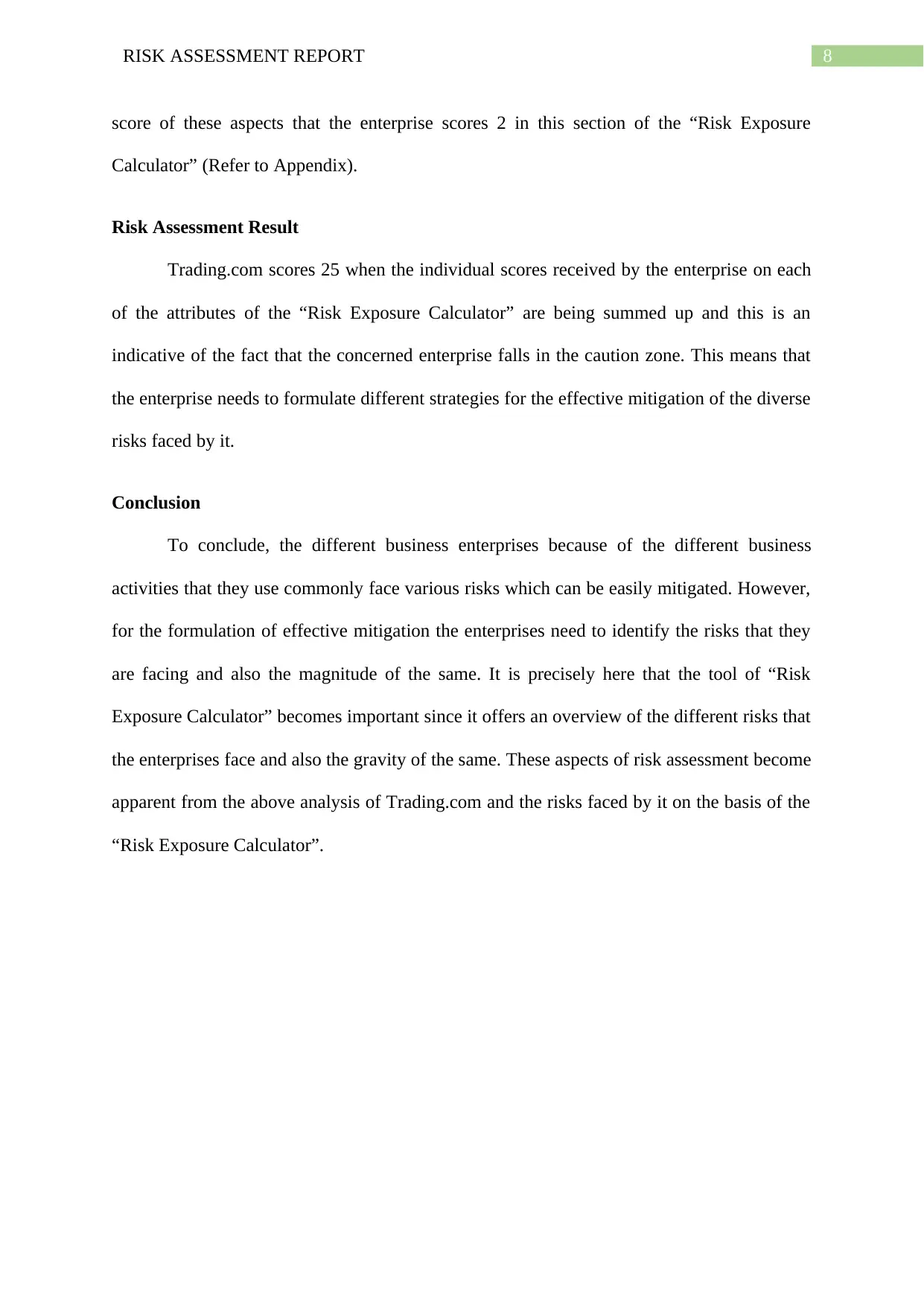
8RISK ASSESSMENT REPORT
score of these aspects that the enterprise scores 2 in this section of the “Risk Exposure
Calculator” (Refer to Appendix).
Risk Assessment Result
Trading.com scores 25 when the individual scores received by the enterprise on each
of the attributes of the “Risk Exposure Calculator” are being summed up and this is an
indicative of the fact that the concerned enterprise falls in the caution zone. This means that
the enterprise needs to formulate different strategies for the effective mitigation of the diverse
risks faced by it.
Conclusion
To conclude, the different business enterprises because of the different business
activities that they use commonly face various risks which can be easily mitigated. However,
for the formulation of effective mitigation the enterprises need to identify the risks that they
are facing and also the magnitude of the same. It is precisely here that the tool of “Risk
Exposure Calculator” becomes important since it offers an overview of the different risks that
the enterprises face and also the gravity of the same. These aspects of risk assessment become
apparent from the above analysis of Trading.com and the risks faced by it on the basis of the
“Risk Exposure Calculator”.
score of these aspects that the enterprise scores 2 in this section of the “Risk Exposure
Calculator” (Refer to Appendix).
Risk Assessment Result
Trading.com scores 25 when the individual scores received by the enterprise on each
of the attributes of the “Risk Exposure Calculator” are being summed up and this is an
indicative of the fact that the concerned enterprise falls in the caution zone. This means that
the enterprise needs to formulate different strategies for the effective mitigation of the diverse
risks faced by it.
Conclusion
To conclude, the different business enterprises because of the different business
activities that they use commonly face various risks which can be easily mitigated. However,
for the formulation of effective mitigation the enterprises need to identify the risks that they
are facing and also the magnitude of the same. It is precisely here that the tool of “Risk
Exposure Calculator” becomes important since it offers an overview of the different risks that
the enterprises face and also the gravity of the same. These aspects of risk assessment become
apparent from the above analysis of Trading.com and the risks faced by it on the basis of the
“Risk Exposure Calculator”.
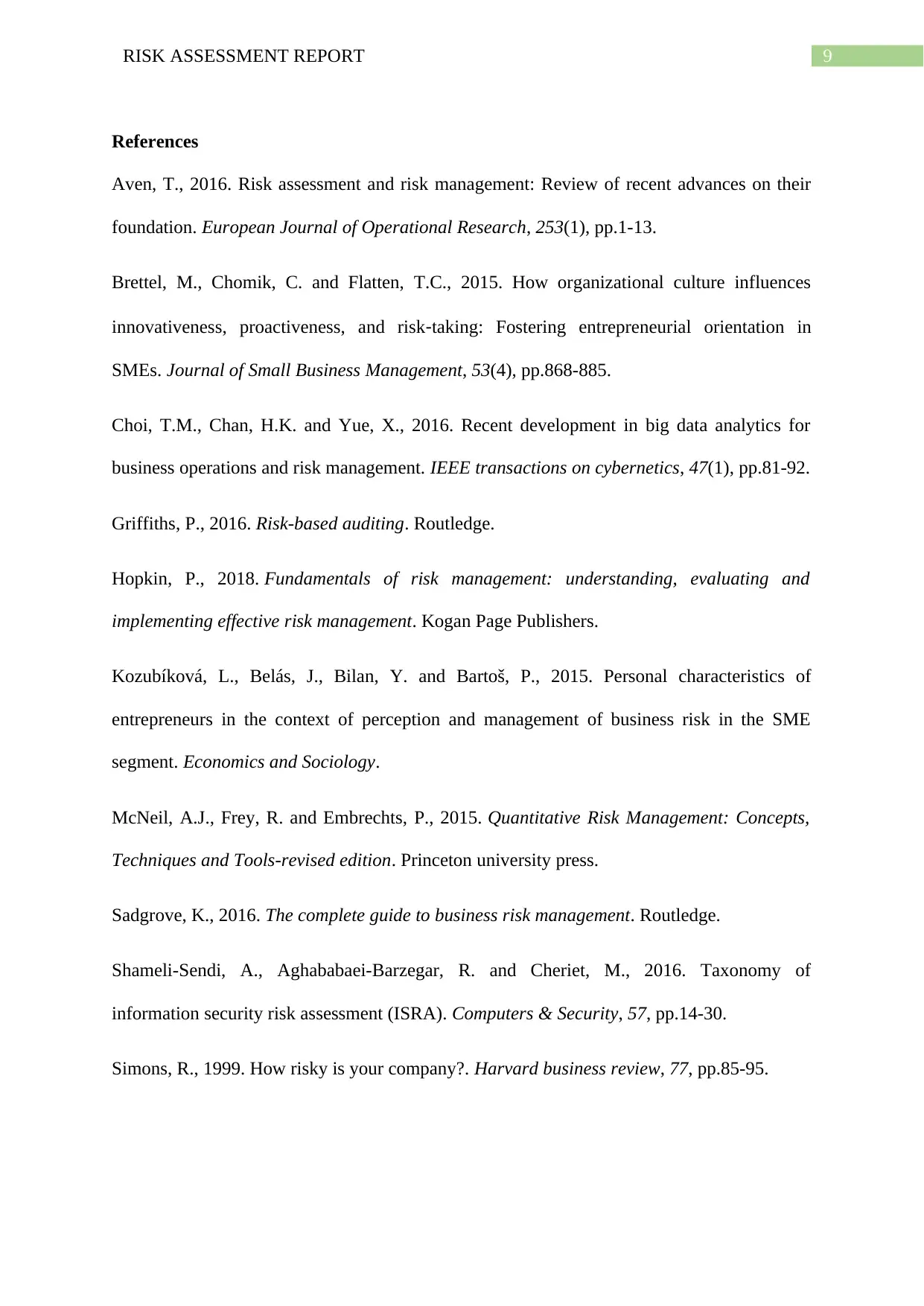
9RISK ASSESSMENT REPORT
References
Aven, T., 2016. Risk assessment and risk management: Review of recent advances on their
foundation. European Journal of Operational Research, 253(1), pp.1-13.
Brettel, M., Chomik, C. and Flatten, T.C., 2015. How organizational culture influences
innovativeness, proactiveness, and risk‐taking: Fostering entrepreneurial orientation in
SMEs. Journal of Small Business Management, 53(4), pp.868-885.
Choi, T.M., Chan, H.K. and Yue, X., 2016. Recent development in big data analytics for
business operations and risk management. IEEE transactions on cybernetics, 47(1), pp.81-92.
Griffiths, P., 2016. Risk-based auditing. Routledge.
Hopkin, P., 2018. Fundamentals of risk management: understanding, evaluating and
implementing effective risk management. Kogan Page Publishers.
Kozubíková, L., Belás, J., Bilan, Y. and Bartoš, P., 2015. Personal characteristics of
entrepreneurs in the context of perception and management of business risk in the SME
segment. Economics and Sociology.
McNeil, A.J., Frey, R. and Embrechts, P., 2015. Quantitative Risk Management: Concepts,
Techniques and Tools-revised edition. Princeton university press.
Sadgrove, K., 2016. The complete guide to business risk management. Routledge.
Shameli-Sendi, A., Aghababaei-Barzegar, R. and Cheriet, M., 2016. Taxonomy of
information security risk assessment (ISRA). Computers & Security, 57, pp.14-30.
Simons, R., 1999. How risky is your company?. Harvard business review, 77, pp.85-95.
References
Aven, T., 2016. Risk assessment and risk management: Review of recent advances on their
foundation. European Journal of Operational Research, 253(1), pp.1-13.
Brettel, M., Chomik, C. and Flatten, T.C., 2015. How organizational culture influences
innovativeness, proactiveness, and risk‐taking: Fostering entrepreneurial orientation in
SMEs. Journal of Small Business Management, 53(4), pp.868-885.
Choi, T.M., Chan, H.K. and Yue, X., 2016. Recent development in big data analytics for
business operations and risk management. IEEE transactions on cybernetics, 47(1), pp.81-92.
Griffiths, P., 2016. Risk-based auditing. Routledge.
Hopkin, P., 2018. Fundamentals of risk management: understanding, evaluating and
implementing effective risk management. Kogan Page Publishers.
Kozubíková, L., Belás, J., Bilan, Y. and Bartoš, P., 2015. Personal characteristics of
entrepreneurs in the context of perception and management of business risk in the SME
segment. Economics and Sociology.
McNeil, A.J., Frey, R. and Embrechts, P., 2015. Quantitative Risk Management: Concepts,
Techniques and Tools-revised edition. Princeton university press.
Sadgrove, K., 2016. The complete guide to business risk management. Routledge.
Shameli-Sendi, A., Aghababaei-Barzegar, R. and Cheriet, M., 2016. Taxonomy of
information security risk assessment (ISRA). Computers & Security, 57, pp.14-30.
Simons, R., 1999. How risky is your company?. Harvard business review, 77, pp.85-95.
Secure Best Marks with AI Grader
Need help grading? Try our AI Grader for instant feedback on your assignments.
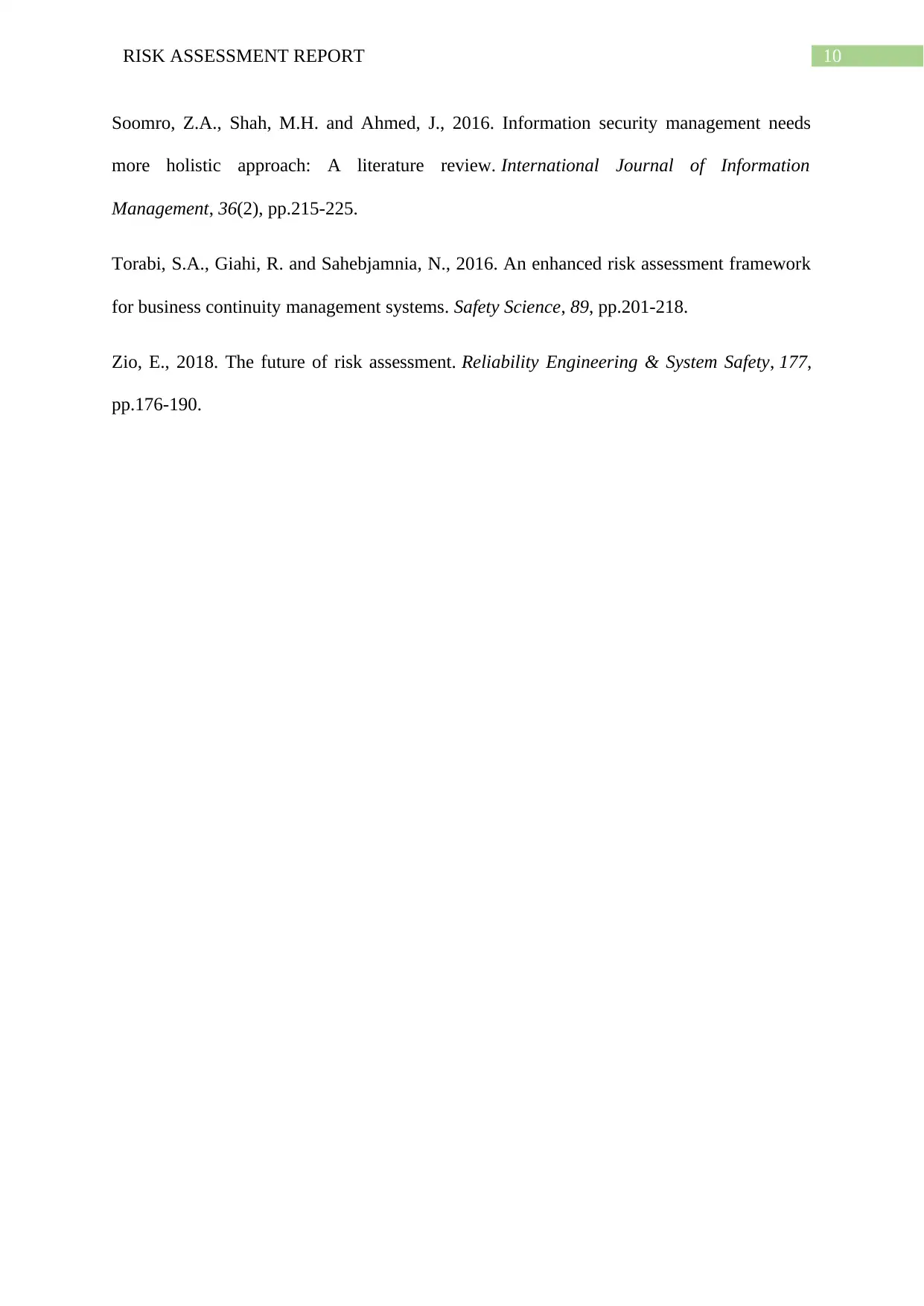
10RISK ASSESSMENT REPORT
Soomro, Z.A., Shah, M.H. and Ahmed, J., 2016. Information security management needs
more holistic approach: A literature review. International Journal of Information
Management, 36(2), pp.215-225.
Torabi, S.A., Giahi, R. and Sahebjamnia, N., 2016. An enhanced risk assessment framework
for business continuity management systems. Safety Science, 89, pp.201-218.
Zio, E., 2018. The future of risk assessment. Reliability Engineering & System Safety, 177,
pp.176-190.
Soomro, Z.A., Shah, M.H. and Ahmed, J., 2016. Information security management needs
more holistic approach: A literature review. International Journal of Information
Management, 36(2), pp.215-225.
Torabi, S.A., Giahi, R. and Sahebjamnia, N., 2016. An enhanced risk assessment framework
for business continuity management systems. Safety Science, 89, pp.201-218.
Zio, E., 2018. The future of risk assessment. Reliability Engineering & System Safety, 177,
pp.176-190.
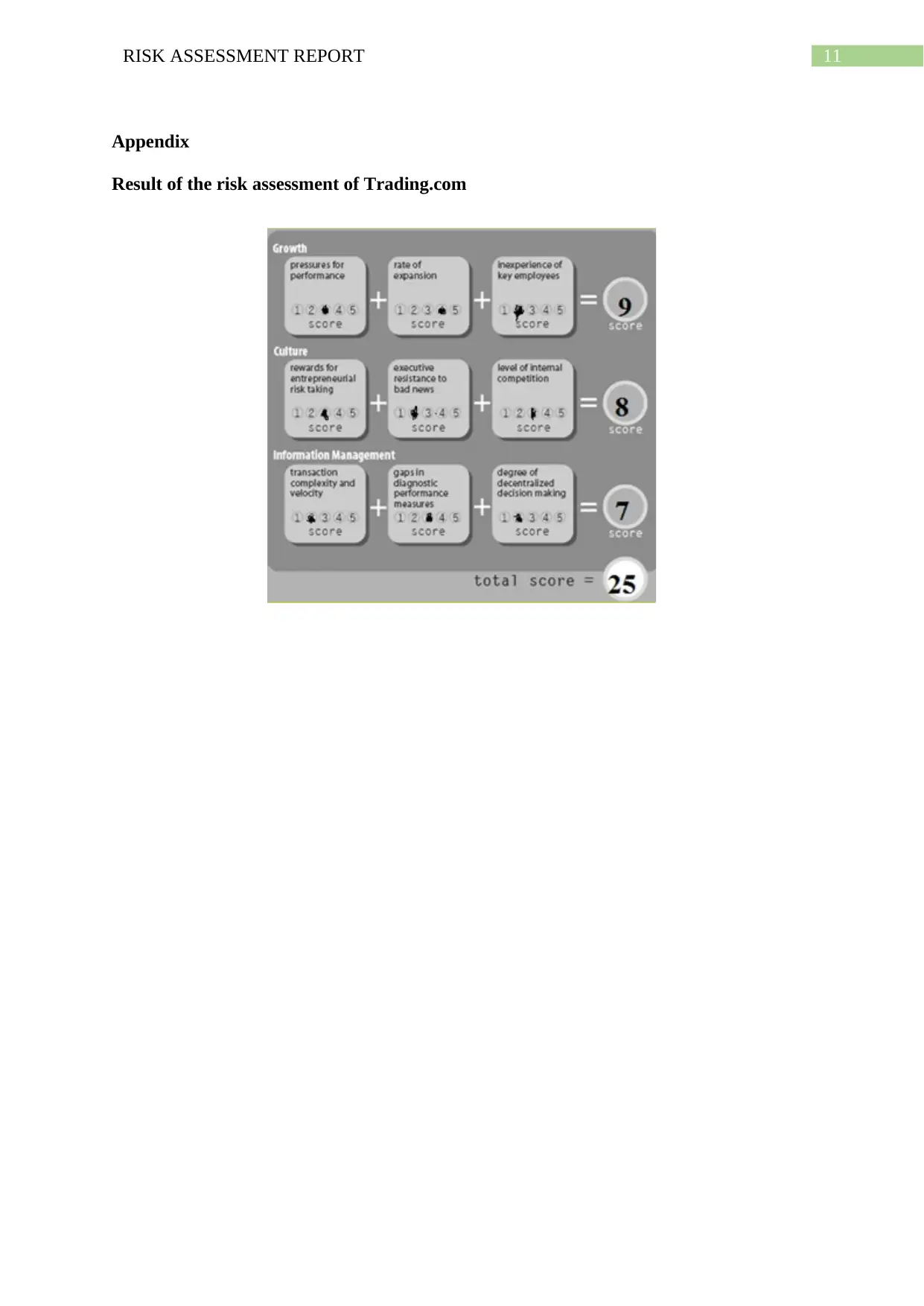
11RISK ASSESSMENT REPORT
Appendix
Result of the risk assessment of Trading.com
Appendix
Result of the risk assessment of Trading.com
1 out of 12
Related Documents
Your All-in-One AI-Powered Toolkit for Academic Success.
+13062052269
info@desklib.com
Available 24*7 on WhatsApp / Email
![[object Object]](/_next/static/media/star-bottom.7253800d.svg)
Unlock your academic potential
© 2024 | Zucol Services PVT LTD | All rights reserved.





